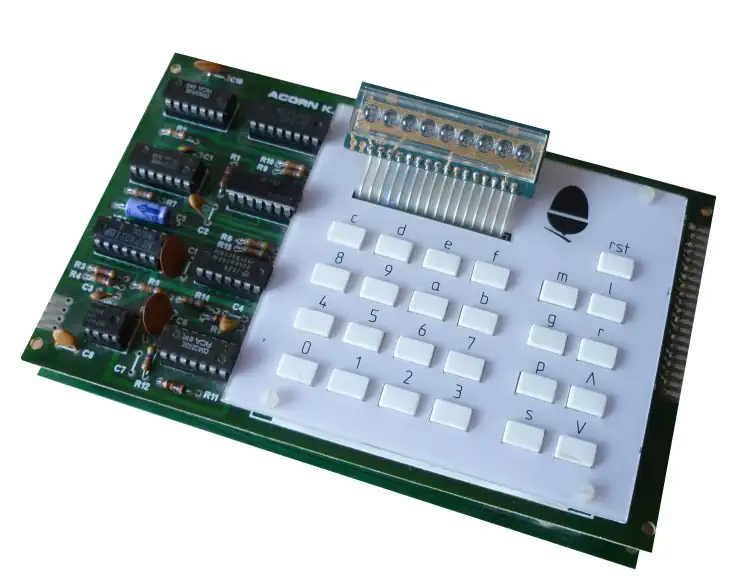The Acorn System 1 or the Acorn Micro-Computer
The Acorn System 1 was an early 8-bit computer kit for hobbyists. It was based on the MOS 6502 Architecture and manufactured by Acorn starting 1979. The main design was done by the Cambridge-undergraduate student Sophie Wilson, and the cassette interface was designed by Steve Furber. This was Acorn's first computer.
Features
- Seven segment LED display
- 25 hexadecimal and function keys
- Cassette CUTS interface
- 6502 CPU running at 1MHz
- INS8154 RAMIO integrated circuit
- 2x2114 1024x4 RAM chips
- 2x74S571 512x4 PROM chip
- Optional INS8154 RAMIO Expansion Chip
- Socket for optional additional ROM or EEPROM
- 7.5V external power supply, 5V on-board regulator
- Two stacked circuit boards connected by a semi-flexible multi-conductor cable (Spectra Strip)
Acorn System VDU board
The Acorn Visual Display Unit Controller Board connects to the Standard Acorn Computer Bus and contains a memory mapped character storage R.A.M. which is transparently written to or read from by the C.P.U.
An MC6845 programmable controller I.C. provides all the synchronisation signals to drive a 625 line 50 fields per second V.D.U. together with read addresses for the character R.A.M. Characters are then fed to an SAA5050 character generator IC which produces the necessary dot patterns to create the characters to refresh the V.D.U.
The SAA5050 produces Teletext standard characters and has Red, Green and Blue drive outputs giving coloured characters or graphics.
The R.G.B. and sync outputs may be used to drive a colour encoder and modulator for a U.H.F. Television; also provided is a 1 volt/75 ohm composite sync and video output which can directly drive a Monochrome Monitor on which the different colours will appear as different scales of grey.
Also provided are listings for programs which set up the MC6845, display 25 instructions in hex on the V.D.U. (with double or treble byte instructions on a single line) and allow the drawing of graphics or characters on the V.D.U. These programs may be loaded and run using the Acorn System 1 Monitor. A new monitor R.O.M. will shortly be available for linking the V.D.U. and an ASC 11 keyboard to Acorns' 4K Fast BASIC.
The versatility of the programmable MC6845 and the SAA5050 combination may be employed to give other screen formats e. g. 80 characters x 16 lines and double height characters. Thus the Acorn V.D.U. should prove to be of great value to experimenters and producers of specialist display systems. The V.D.U. controller P C B is supplied in kit form with a full set of I.C. sockets. It is easily assembled using a small soldering iron and useful hints on assembly may be found in the Acorn Micro-computer System 1 Technical Manual. The board operates from a single +5v supply from which it draws not more than 500 mA.
CPU View - MOS 6502
The 6502 is an 8-bit MicroProcessor designed by MOS Technology. The team was led by Chuck Peddle and had also worked on the Motorola 6800. The 6502 is a simplified, but faster and cheaper design than the 6800.
The 6502 was introduced in 1975 and was the cheapest microprocessor on the market. Together with the Zilog Z80, the 6502 helped start the home computer revolution of the 1980s. The 6502 was used in a wide range of devices: the Atari 2600, the 8-bit Atari home computers, the Apple II, the Nintendo Entertainment System, the Commodore 64, the BBC Micro and many others. All used the 6502 or a variation of it.
The 6502 is a 1MHz design, while the 6502A is designed for 2MHz. The 6502A is 100% compatible with the original 6502.
Commodore soon bought MOS Technology, but conitnued to sell the microprocessor to competitors and licensed the design to other manufacturers.
Source: WikiPedia - MOS Technology 6502

